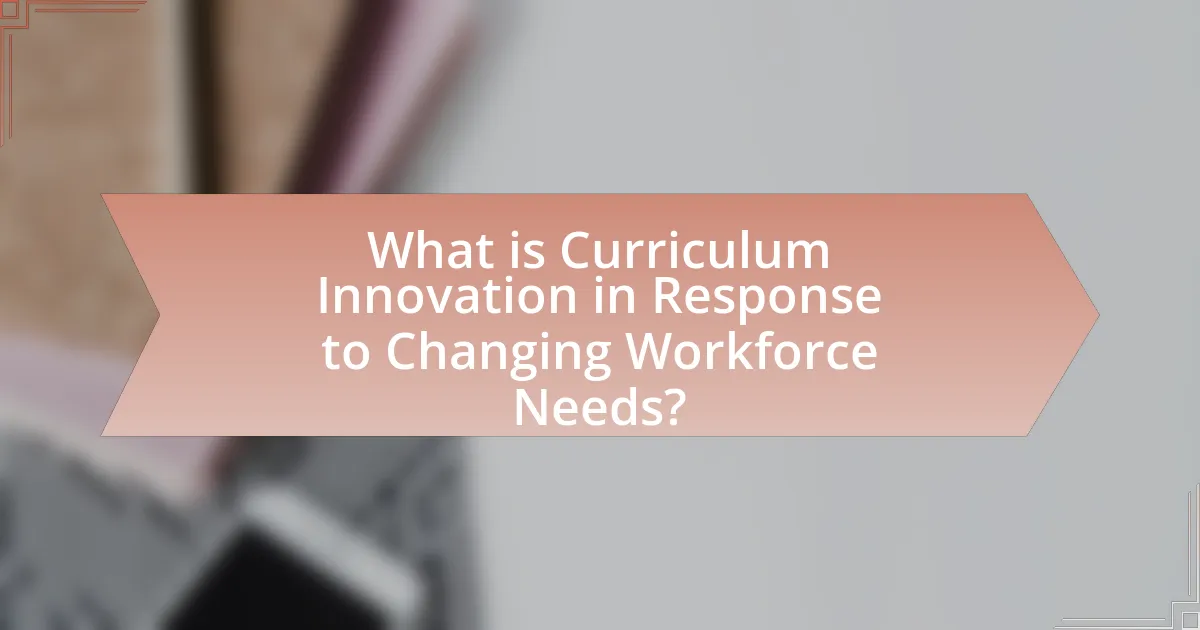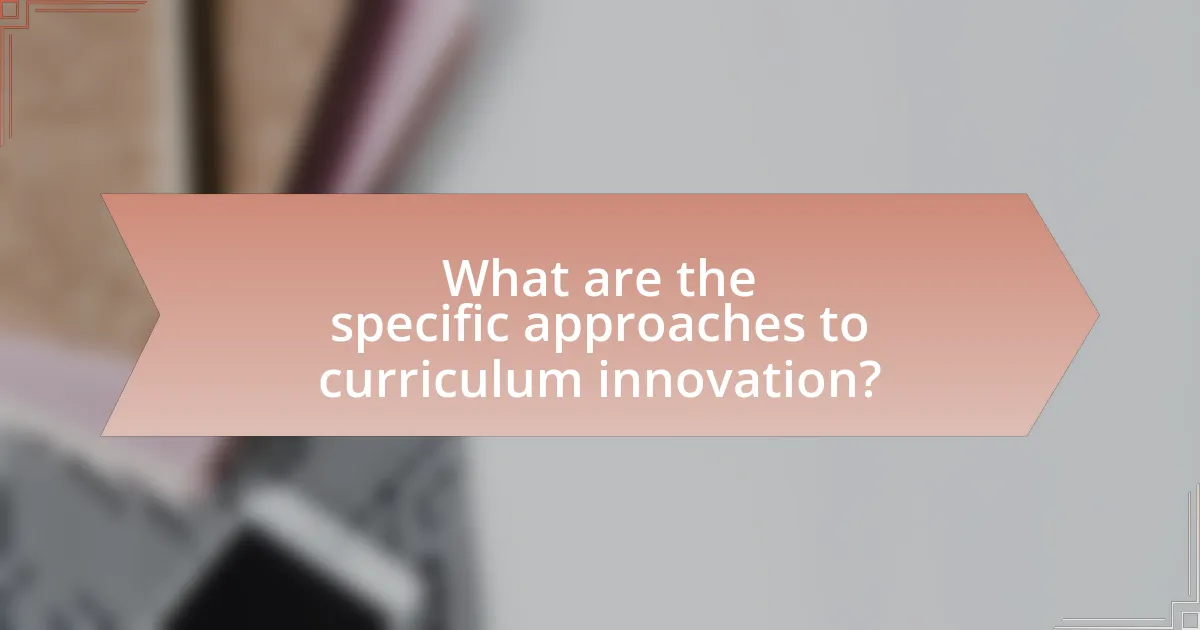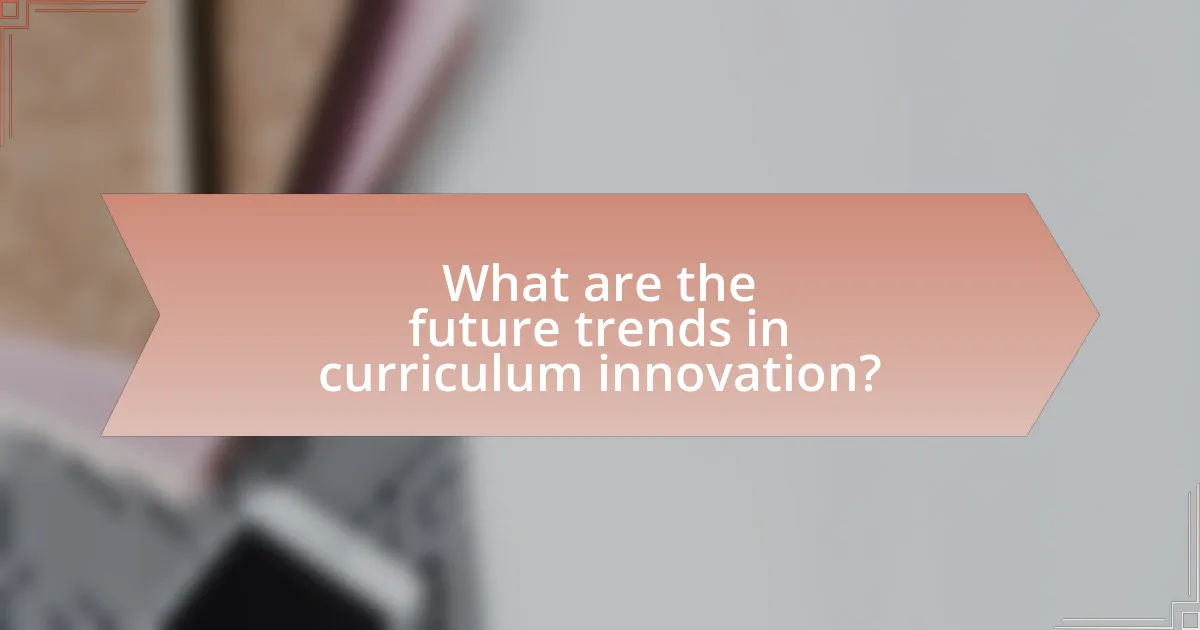Curriculum innovation in response to changing workforce needs involves systematic updates to educational programs to align with the evolving skills required by employers. This article explores how curriculum innovation addresses workforce demands through industry collaboration, experiential learning, and the integration of technology. Key drivers of workforce change, such as technological advancements and demographic shifts, are examined, along with strategies for educational institutions to identify and adapt to these needs. The article also discusses the importance of stakeholder collaboration, the role of data analytics in curriculum assessment, and future trends in education, emphasizing the necessity of aligning curricula with emerging fields and essential skills for the modern job market.

What is Curriculum Innovation in Response to Changing Workforce Needs?
Curriculum innovation in response to changing workforce needs refers to the systematic updates and modifications made to educational programs to align with the evolving skills and competencies required by employers. This process is driven by factors such as technological advancements, shifts in industry demands, and the need for a skilled workforce capable of adapting to new challenges. For instance, a report by the World Economic Forum highlights that 85 million jobs may be displaced by a shift in labor between humans and machines by 2025, necessitating educational institutions to revise curricula to include digital literacy and critical thinking skills. Therefore, curriculum innovation is essential for preparing students to meet the current and future demands of the job market effectively.
How does curriculum innovation address workforce demands?
Curriculum innovation addresses workforce demands by aligning educational programs with the skills and competencies required by employers. This alignment is achieved through the integration of industry-relevant content, experiential learning opportunities, and collaboration with businesses to ensure that graduates possess the necessary qualifications. For instance, a report by the World Economic Forum highlights that 94% of business leaders expect employees to acquire new skills on the job, prompting educational institutions to adapt their curricula accordingly. By incorporating feedback from industry stakeholders, curriculum innovation ensures that students are equipped with the practical skills and knowledge that meet current labor market needs.
What are the key drivers of workforce change?
The key drivers of workforce change include technological advancements, demographic shifts, globalization, and evolving employee expectations. Technological advancements, such as automation and artificial intelligence, are reshaping job roles and required skills, leading to a demand for continuous learning and adaptation. Demographic shifts, including an aging workforce and increasing diversity, influence workforce composition and necessitate inclusive practices. Globalization expands market reach and competition, prompting organizations to adapt their strategies and workforce capabilities. Evolving employee expectations, particularly regarding work-life balance and corporate social responsibility, drive organizations to rethink their workplace policies and culture. These factors collectively necessitate curriculum innovation to align educational programs with the skills and competencies needed in the modern workforce.
How do educational institutions identify these changing needs?
Educational institutions identify changing workforce needs through comprehensive market research, stakeholder feedback, and data analysis. They conduct surveys and interviews with employers, alumni, and industry experts to gather insights on skills gaps and emerging trends. For instance, a report by the World Economic Forum highlights that 94% of business leaders expect employees to pick up new skills on the job, prompting institutions to adapt curricula accordingly. Additionally, institutions analyze labor market data and employment statistics to align educational offerings with current and future job demands, ensuring that graduates possess relevant competencies.
Why is curriculum innovation essential for modern education?
Curriculum innovation is essential for modern education because it aligns educational practices with the evolving demands of the workforce. As industries rapidly change due to technological advancements and globalization, educational institutions must adapt their curricula to equip students with relevant skills and knowledge. For instance, a report by the World Economic Forum highlights that 85 million jobs may be displaced by shifts in labor between 2025 and 2030, necessitating a curriculum that fosters critical thinking, creativity, and digital literacy. This adaptability ensures that graduates are prepared to meet the needs of employers and thrive in a competitive job market.
What role does technology play in curriculum innovation?
Technology plays a crucial role in curriculum innovation by enabling personalized learning experiences and facilitating access to diverse educational resources. It allows educators to integrate interactive tools, such as online platforms and multimedia content, which enhance student engagement and cater to various learning styles. For instance, the use of learning management systems has been shown to improve student performance by providing tailored feedback and resources, as evidenced by a study from the Bill & Melinda Gates Foundation, which found that technology-enhanced courses can lead to higher completion rates. Additionally, technology supports the development of skills relevant to the modern workforce, such as digital literacy and collaboration, aligning educational outcomes with industry demands.
How does curriculum innovation enhance student employability?
Curriculum innovation enhances student employability by aligning educational programs with the evolving demands of the job market. This alignment ensures that students acquire relevant skills and knowledge that employers seek, such as critical thinking, problem-solving, and technical competencies. For instance, a study by the World Economic Forum highlights that 94% of business leaders expect employees to possess skills that are not currently being taught in traditional education systems. By integrating real-world projects, internships, and industry partnerships into the curriculum, educational institutions can provide students with practical experience and networking opportunities, further increasing their employability.
What are the challenges faced in implementing curriculum innovation?
The challenges faced in implementing curriculum innovation include resistance to change, lack of resources, and insufficient training for educators. Resistance to change often stems from established practices and fear of the unknown, which can hinder the adoption of new curricula. A study by Fullan (2007) highlights that educators may be reluctant to embrace innovative approaches due to concerns about their effectiveness and the potential disruption to existing systems. Additionally, lack of resources, including funding and materials, can impede the development and execution of innovative curricula, as noted in the report by the National Center for Education Statistics (2019), which indicates that many schools struggle with budget constraints. Finally, insufficient training for educators can lead to ineffective implementation, as teachers may not feel equipped to deliver new content or methodologies, a challenge emphasized in research by Darling-Hammond et al. (2017), which found that professional development is crucial for successful curriculum innovation.
How do institutional barriers affect curriculum changes?
Institutional barriers significantly hinder curriculum changes by creating rigid structures that resist adaptation to new workforce demands. These barriers include bureaucratic processes, lack of funding, and resistance from faculty or administration, which can delay or prevent the implementation of innovative curricula. For instance, a study by the National Center for Education Statistics found that institutions with complex governance structures are less likely to adopt new programs that align with evolving industry needs. This resistance can lead to a misalignment between educational offerings and the skills required in the job market, ultimately affecting graduates’ employability.
What resistance might educators face during this process?
Educators might face resistance from various stakeholders, including administrators, parents, and students, during the process of curriculum innovation in response to changing workforce needs. This resistance often stems from concerns about the effectiveness of new teaching methods, fear of change, and the perceived disruption to established educational practices. For instance, a study by the National Center for Education Statistics indicates that 60% of teachers report feeling unprepared to implement new curricula, highlighting a significant barrier to adoption. Additionally, parents may resist changes due to a lack of understanding of the benefits, while students might be hesitant to engage with unfamiliar content. These factors collectively contribute to the challenges educators encounter in successfully implementing innovative curricula.
How can stakeholders collaborate for effective curriculum innovation?
Stakeholders can collaborate for effective curriculum innovation by establishing partnerships that integrate diverse perspectives and expertise. This collaboration can involve educators, industry leaders, policymakers, and community members working together to identify skills gaps and emerging workforce needs. For instance, research from the National Center for Education Statistics indicates that aligning curriculum with industry standards enhances student employability and addresses labor market demands. By engaging in regular dialogue and sharing resources, stakeholders can co-create curricula that are relevant, adaptive, and responsive to the evolving landscape of work.
What strategies can be employed to ensure curriculum relevance?
To ensure curriculum relevance, institutions should implement continuous stakeholder engagement, aligning educational content with industry needs. This strategy involves regularly consulting with employers, alumni, and industry experts to gather insights on skills and knowledge gaps. For instance, a study by the National Center for Education Statistics found that 70% of employers prioritize graduates with practical skills relevant to their field, highlighting the necessity for curricula to adapt accordingly. Additionally, integrating real-world projects and internships into the curriculum can enhance practical learning and ensure that students acquire applicable skills.

What are the specific approaches to curriculum innovation?
Specific approaches to curriculum innovation include competency-based education, interdisciplinary learning, project-based learning, and the integration of technology. Competency-based education focuses on students mastering specific skills and knowledge at their own pace, which aligns with workforce demands for skilled professionals. Interdisciplinary learning combines subjects to provide a holistic understanding, preparing students for complex real-world problems. Project-based learning engages students in hands-on projects that reflect actual workplace scenarios, enhancing practical skills. The integration of technology in the curriculum, such as online learning platforms and digital tools, equips students with essential digital literacy skills required in modern workplaces. These approaches are validated by educational research indicating their effectiveness in meeting evolving workforce needs.
How can experiential learning be integrated into the curriculum?
Experiential learning can be integrated into the curriculum by incorporating hands-on projects, internships, and real-world problem-solving activities that align with academic content. This approach allows students to apply theoretical knowledge in practical settings, enhancing their understanding and retention of the material. Research by Kolb (1984) emphasizes that experiential learning fosters critical thinking and adaptability, skills essential for the modern workforce. Additionally, programs that partner with local businesses for internships provide students with direct exposure to industry practices, thereby bridging the gap between education and employment.
What are the benefits of project-based learning?
Project-based learning enhances student engagement and retention of knowledge by allowing learners to apply concepts in real-world scenarios. This approach fosters critical thinking, collaboration, and problem-solving skills, which are essential in today’s workforce. Research indicates that students involved in project-based learning demonstrate higher academic achievement and improved attitudes toward learning compared to traditional instructional methods. For instance, a study published in the “Journal of Educational Psychology” found that students engaged in project-based learning scored significantly higher on assessments than their peers in conventional classrooms, highlighting its effectiveness in preparing students for future employment challenges.
How does internships and co-op programs enhance learning?
Internships and co-op programs enhance learning by providing practical, hands-on experience that complements academic knowledge. These programs allow students to apply theoretical concepts in real-world settings, facilitating deeper understanding and retention of information. Research indicates that students who participate in internships are more likely to secure employment after graduation, with a study by the National Association of Colleges and Employers showing that 60% of interns receive job offers from their internship employers. This practical exposure not only builds essential skills but also fosters professional networks, further enriching the learning experience.
What role does industry partnership play in curriculum development?
Industry partnerships play a crucial role in curriculum development by ensuring that educational programs align with current workforce demands. These collaborations provide insights into industry trends, skills requirements, and technological advancements, which help educators design relevant and practical curricula. For instance, a study by the National Center for Education Statistics found that programs incorporating industry input significantly improved student employability and job readiness. By integrating real-world experiences and feedback from industry professionals, educational institutions can enhance the quality and applicability of their curricula, ultimately bridging the gap between education and employment.
How can feedback from employers shape curriculum content?
Feedback from employers can significantly shape curriculum content by ensuring that educational programs align with industry needs and workforce skills. When employers provide insights on the competencies and knowledge required for specific roles, educational institutions can adjust their curriculum to include relevant topics, practical skills, and real-world applications. For instance, a study by the National Center for Education Statistics found that 70% of employers believe that graduates lack the necessary skills for the workforce, highlighting the importance of integrating employer feedback into curriculum design. This alignment not only enhances student employability but also fosters a more responsive educational system that meets the evolving demands of the job market.
What are successful examples of industry-academic collaborations?
Successful examples of industry-academic collaborations include the partnership between IBM and various universities to develop curricula focused on artificial intelligence and data science. This collaboration has led to the creation of specialized programs that align academic training with industry needs, resulting in a workforce better equipped for current technological demands. Additionally, the collaboration between the University of California, Berkeley, and several tech companies has fostered research initiatives that directly inform curriculum development, ensuring that students gain relevant skills that meet employer expectations. These partnerships demonstrate how aligning educational programs with industry requirements can enhance employability and address workforce gaps.
How can data analytics inform curriculum innovation?
Data analytics can inform curriculum innovation by identifying skill gaps and aligning educational offerings with industry demands. By analyzing data from job market trends, student performance metrics, and employer feedback, educational institutions can adapt their curricula to better prepare students for the evolving workforce. For instance, a study by the World Economic Forum found that 54% of all employees will require significant reskilling by 2022, highlighting the need for curricula that address emerging skills. This data-driven approach ensures that educational programs remain relevant and effective in meeting the needs of both students and employers.
What types of data are most useful for curriculum assessment?
The most useful types of data for curriculum assessment include student performance data, feedback from stakeholders, and alignment with industry standards. Student performance data, such as test scores and grades, provides quantitative measures of learning outcomes, allowing educators to identify areas needing improvement. Feedback from stakeholders, including students, teachers, and employers, offers qualitative insights into the curriculum’s effectiveness and relevance. Additionally, alignment with industry standards ensures that the curriculum meets current workforce needs, as evidenced by research indicating that curricula aligned with industry expectations lead to better job readiness for graduates.
How can institutions measure the effectiveness of curriculum changes?
Institutions can measure the effectiveness of curriculum changes through a combination of student performance metrics, feedback mechanisms, and alignment with workforce requirements. By analyzing student grades, retention rates, and graduation rates before and after curriculum implementation, institutions can quantitatively assess the impact of changes. Additionally, collecting qualitative feedback from students and faculty through surveys and focus groups provides insights into the perceived relevance and effectiveness of the curriculum. Furthermore, aligning curriculum outcomes with industry standards and employer feedback ensures that the changes meet current workforce needs, thereby validating their effectiveness. For instance, a study by the National Center for Education Statistics found that institutions that regularly assess curriculum effectiveness through these methods see improved student outcomes and better alignment with job market demands.

What are the future trends in curriculum innovation?
Future trends in curriculum innovation include the integration of technology, personalized learning, and interdisciplinary approaches. The incorporation of technology, such as artificial intelligence and virtual reality, enhances engagement and provides immersive learning experiences. Personalized learning tailors educational experiences to individual student needs, promoting better outcomes and engagement. Interdisciplinary approaches encourage collaboration across subjects, reflecting real-world complexities and preparing students for diverse career paths. These trends are supported by research indicating that technology-enhanced learning environments improve retention rates and that personalized learning can lead to significant academic gains.
How is artificial intelligence influencing curriculum design?
Artificial intelligence is significantly influencing curriculum design by enabling personalized learning experiences and data-driven decision-making. AI technologies analyze student performance and learning styles, allowing educators to tailor content and instructional methods to meet individual needs. For instance, adaptive learning platforms utilize algorithms to adjust the difficulty of tasks based on real-time assessments, enhancing student engagement and retention. Research from the Brookings Institution highlights that AI can help identify skill gaps in students, guiding curriculum adjustments to better align with industry demands. This integration of AI in curriculum design not only fosters a more effective learning environment but also prepares students for the evolving workforce landscape.
What are the implications of personalized learning pathways?
Personalized learning pathways significantly enhance educational outcomes by tailoring learning experiences to individual student needs, preferences, and goals. This approach fosters greater engagement and motivation, as students can progress at their own pace and focus on areas that align with their career aspirations. Research indicates that personalized learning can lead to improved academic performance; for instance, a study by the Bill & Melinda Gates Foundation found that personalized learning initiatives resulted in a 20% increase in student achievement in mathematics and reading. Additionally, personalized pathways prepare students for the workforce by equipping them with relevant skills and knowledge, aligning educational content with industry demands. This alignment is crucial as it addresses the skills gap in the labor market, ensuring that graduates are better prepared for employment opportunities.
How can adaptive learning technologies be utilized?
Adaptive learning technologies can be utilized to personalize educational experiences by adjusting content and assessments based on individual learner performance and preferences. These technologies analyze data from student interactions to identify strengths and weaknesses, enabling tailored learning paths that enhance engagement and retention. For instance, platforms like DreamBox Learning and Smart Sparrow have demonstrated effectiveness in improving student outcomes by providing real-time feedback and customized resources, which aligns with the increasing demand for skills relevant to the evolving workforce.
What skills will be prioritized in future curricula?
Future curricula will prioritize skills such as critical thinking, digital literacy, and emotional intelligence. These skills are essential for adapting to the rapidly changing workforce landscape driven by technological advancements and globalization. Research indicates that employers increasingly seek candidates who can analyze complex problems, utilize digital tools effectively, and collaborate with diverse teams, highlighting the need for educational institutions to align their programs with these demands. For instance, a report by the World Economic Forum emphasizes that by 2025, critical thinking and problem-solving will be among the top skills required in the job market, reinforcing the necessity for curricula to evolve accordingly.
How can soft skills be integrated into technical education?
Soft skills can be integrated into technical education through project-based learning, collaborative assignments, and communication-focused assessments. Project-based learning allows students to work in teams, fostering teamwork and problem-solving skills essential in the workforce. Collaborative assignments encourage peer interaction, enhancing interpersonal skills and adaptability. Communication-focused assessments, such as presentations and reports, develop verbal and written communication abilities, which are critical in technical fields. Research indicates that employers prioritize soft skills alongside technical expertise, with a survey by the National Association of Colleges and Employers showing that 73% of employers seek candidates with strong communication skills.
What emerging fields should be included in curriculum updates?
Emerging fields that should be included in curriculum updates are artificial intelligence, data science, cybersecurity, and renewable energy technologies. These fields are increasingly relevant due to the rapid advancement of technology and the growing demand for skilled professionals in these areas. For instance, the World Economic Forum’s “Future of Jobs Report 2020” highlights that by 2025, 85 million jobs may be displaced by a shift in labor between humans and machines, while 97 million new roles may emerge that are more adapted to the new division of labor. This underscores the necessity for educational institutions to adapt their curricula to prepare students for these evolving job markets.
What best practices can guide successful curriculum innovation?
Successful curriculum innovation can be guided by several best practices, including stakeholder engagement, iterative design, and alignment with industry standards. Engaging stakeholders such as educators, students, and industry representatives ensures that the curriculum meets the needs of all parties involved. Iterative design allows for continuous feedback and improvement, which is essential in adapting to changing workforce demands. Aligning the curriculum with industry standards ensures relevance and prepares students for real-world challenges. Research indicates that programs incorporating these practices see higher student satisfaction and better job placement rates, demonstrating their effectiveness in fostering successful curriculum innovation.


